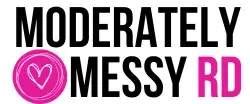
BLW vs. purees – is one better than the other? This seems to be a common question among new moms.
In this post, we will discuss the pros and cons to each method and answer some of the most common questions when it comes to baby led weaning.
There’s actually no right or wrong way to introduce your baby to solids, as both can offer benefits. Hopefully by the end of this post, you’ll have a better understanding of which one is right for you – or if you want to try a hybrid approach.
Importance of Introducing Solids
The term “weaning” is the process of introducing solids with the goal of eliminating breastmilk or formula. Whether it’s baby-led or the more traditional purée route, introducing solids helps to fill the nutritional gaps in a baby’s diet.
Six months is often recommended to begin solids because babies need extra nutrients which are not found in milk, specifically iron, vitamin C and zinc (1). Offering solids is also very important for developing motor skills.
That being said, breastmilk or formula should provide most of their needs that first year.
What is BLW (Baby Led Weaning)?
Baby led weaning is an increasingly popular way of expanding a baby’s diet. It involves serving your baby finger foods around 6 months, usually prepared in finger-like shapes to promote self-feeding.

Can You Feed Purees With BLW?
The answer is yes! However, baby led weaning encourages self-feeding by pre-loading the spoon and letting the baby bring it to their mouth, instead of the parent spoon feeding.
Advantages of BLW
Encourages self-regulation and self-feeding: Baby-led weaning allows the child to set the pace, which can not only improve their feeding skills in the nutritional sense but also help the development of their motor skills (2).
Less work: For the most part, the baby can eat right along with the rest of the family. The foods will need to be served appropriately, but separate items don’t have to be made.
Baby becomes familiar with a variety of textures and flavors: BLW advocates recognize that introducing your baby to different textures at a young age may lead to a diet higher in variety, and help to combat picky eating.
May prevent obesity: Baby led weaning relies on the baby determining what they want to eat, and how much, based on their hunger levels. Whereas with spoon-feeding, the parent is in control. Therefore, babies may eat more than they actually need.
Is Baby-Led Weaning Scientifically Proven?
A recent review summarized the evidence of BLW and concluded that the baby-led approach may encourage positive outcomes, but further research is needed (3). Unfortunately, there is a lack of high-quality research due to most studies being observational.
The studies that have been conducted have found that the BLW approach has led to more family meals eaten together, as well as reduced fussy eating and better appetite control.
Why Is BLW Controversial?
Choking Risk
One of the most frequently mentioned fears of parents using BLW is the risk of choking. Multiple scientific studies have shown that infants 6-7 months old have the developmental capacity to eat a variety of solids, and avoidance of these foods may result in food refusal or selective eating in the future (4).
Experts have stated that meals that require biting and chewing pays off in the long run by increasing their acceptance of particular foods and dishes.
When beginning baby led weaning, it is recommended to serve food in finger-like strips no bigger than your pinky finger which makes them easier to eat, and less likely to choke.
However, the American Academy of Pediatrics recommends avoiding round and small products with a smooth or hard surface, similar to a child’s airway – such as sausages, hard candies, seeds and nuts, raw apples and carrots.
By avoiding these foods and following the recommended precautions, experts agree that baby led weaning is just as safe as traditional weaning.
Nutritional Intake
There aren’t many studies that evaluate the nutritional intake of infants doing BLW. It is much more difficult to gauge how much they are consuming as opposed to purees.
In a self-reported study, infants who followed the traditional puree approach were significantly heavier at 18-24 months compared to those following a baby-led approach (4). However, another study found no significant difference between the two (5).
There is speculation that babies who are eating what the rest of the family may have a higher sodium intake than is recommended. Another concern is that self-feeding babies might not be eating enough or getting those key nutrients they need.
That is why it’s recommended to prioritize foods high in iron, zinc, and vitamin C to ensure these nutrient needs are met.
There Are Specific Guidelines You Have to Follow
Baby-led weaning can seem totally overwhelming at first. There is a learning curve – especially to reduce the risks of choking. Understanding how to serve foods properly and which foods to avoid, while juggling all the chaos that is motherhood can add more to our mental load.
It can be pretty scary when you have to remember all these details! It’s a good thing there are many resources out there, and once you get used to it – it’s really not so hard.
1. Solid Starts. Start with these 10 Tips for Starting Solids. Follow them on Instagram, or download their app! They have a database for basically every food, and you can just look each one up on your phone.
2. Feeding Littles. Led by a pediatric dietitian and occupational therapist, they specialize in infant and toddler feeding. There are courses you can take, and their Instagram has a wealth of information and fun, relatable reels.
It’s Messy
Another slight disadvantage of baby led weaning? It can be super messy, especially in the beginning when they’re developing the coordination and strength.
It’s a whole new experience- which often leads to food all over the floor, their highchair, and themselves.
If you decide to go the BLW route, do yourself a favor and invest in a really good bib that cleans easily – like these Tiny Twinkle- Mess Proof Bibs.

How OFten Do Babies Choke with BLW?
So it bears repeating: there is limited research regarding baby-led weaning. That being said, the studies that have been conducted have all concluded that the risk of choking is about the same as purée feeding (6, 7, 8)!
Babies have protective reflexes like gagging, which is totally normal and not to be confused with choking. In fact- it actually protects the baby from choking.
Yet, the risk is still there. Therefore, it’s important to educate yourself on the baby-led weaning guidelines. Always supervise your little one while they’re eating.

Process of Introducing Purees
The World Health Organization recommends infants are introduced to solid foods using spoon feeding, progressing in texture until 12 months of age. This method typically begins with foods that are smooth and soft in texture, either made at home or store-bought.
Advantages of Purees
Controlled Portion Size
Because the parent is in charge of feeding the baby, the portion size is controlled and you can easily track how much your baby has eaten. This can provide the parent a sense of comfort.
Convenience
There are endless options of baby foods in grocery stores and online, making this method very convenient. It’s easy to pack jars of food and bring them out and about for busy days.
Easier Introduction and Control of Specific Nutrients
Since purees are soft and cohesive in texture, it’s easier to introduce them to your baby. Foods rich in iron, zinc, and vitamin C can be prioritized safely with purée feeding.
Less Mess
Since the parent is the one doing the feeding, and not the baby, there is potential for a lot less mess than with BLW.
Your Family Might Feel More Comfortable
The baby-led weaning approach is relatively new, and older adults (like your parents) might not understand it. Purée feeding is widely recognized, so family or friends may feel more comfortable with this approach.

Disadvantages of Traditional Puree Feeding
Baby Might Get Too Used to the Texture
If your baby gets too used to the texture of purées, he or she might be less likely to accept new foods.
Heavy Metal Exposure
Heavy metals have been found in baby food, both store bought and homemade. Certain foods have higher heavy metal exposure than others, so experts recommend serving your baby a variety of different foods as the solution until further research is conducted.
Less Reliance on Baby’s Hunger and Fullness Cues
As discussed previously, this parent feeding approach may ignore cues that baby isn’t hungry anymore. This can be alleviated as long as the parent recognizes when baby is full or is done eating.
It Might Be Unnecessary
Essentially, this traditional approach is just delaying the inevitable – starting solid foods. You’re going to have to introduce them eventually.
BLW vs Purees… Which One?
Selecting which weaning approach is really up to YOU! The topic has become so polarizing, when it doesn’t have to be. With both approaches, the goal is the same – to transition the baby to eating solid foods of varying textures by 12 months of age.
Even with the purée weaning method, it is recommended to start initiating more solid foods by 8-9 months.
If you’re still unsure, many moms combine both approaches!
While there are many potential benefits to baby led weaning, the research is still unclear – and hopefully more studies will be done. Which one did you choose, and would you have done anything differently?
*This post does contain affiliate links, At no cost to you, I receive a small compensation if a purchase is made.
